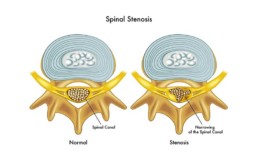Referring in frustration, to a “pain in the neck” is a figurative way of calling someone annoying. However, it’s also an apt descriptor for cervical spinal stenosis, an ailment that literally can cause a pain in your neck – and other places, as well.
Definition
Spinal stenosis refers to the narrowing of the spinal canal, which houses the spinal cord, and the openings in it that provide passage for peripheral nerves that thread their way to other parts of the body. This narrowing can choke the spinal cord and/or the roots of your nerves.
There are two types: cervical spinal stenosis, which affects the spinal column in the neck region, and lumbar spinal stenosis, which narrows the spinal column in the lower back.
What Causes Spinal Stenosis?
Aging is the most prevalent cause of spinal stenosis. As you age, your spine gradually degenerates. The discs between your vertebrae lose height through dehydration; your bones and joints may enlarge due to increased stress on them and destruction of cartilage, potentially leading to bone spurs that occupy space in the spinal canal; and your ligaments may thicken and calcify, encroaching on the space in the nearby canal.
Middle-aged and elderly people are also subject to osteoarthritis of the spine, or spondylosis, which is chronic and the result of wear and tear on the spine. It can also lead to the formation of bone spurs that constrict the spinal canal and cause spinal stenosis.
Although people over the age of 50 are the most likely to suffer from it, younger people who suffer a spinal injury or are born with a narrow spinal canal are also subject to spinal stenosis.

What Are the Symptoms of Spinal Stenosis?
Spinal stenosis may be present without your being aware of it. The spinal canals of many people over 50 narrow, but it only becomes apparent when the nerves are squeezed and they feel the resulting symptoms. It may take time for the symptoms to develop.
Your family physician will generally be able to diagnose spinal stenosis based on your symptoms and your medical history, using appropriate tests to confirm the diagnosis. The doctor may order a magnetic resonance imaging test (MRI), X-rays or computed tomography (CT) scans to rule out other possible causes of the pain.
What Is Cervical Spinal Stenosis?
With cervical spinal stenosis, you may feel some stiffness, pain, numbness or weakening in your hands, shoulders, neck or legs. You may find that you have problems with co-ordination and balance, causing you to stumble when moving or shuffle as you walk. There may be problems with fine-motor skills, such as typing or buttoning a shirt. You may also experience some incontinence.
What Is Lumbar Spinal Stenosis?
If you have lumbar spinal stenosis, leg pain when you’re in motion will usually be your primary symptom, since the nerves in the lower spine extend into the legs. It is often more severe when your spine is extended: for instance, when you are standing straight or leaning backward. The pain generally eases when your spine is flexed: whenever you are sitting, riding a bicycle or bending over your shopping cart.
Lumbar stenosis also manifests itself through additional symptoms, including low back pain; cramping, weakness or numbness in the legs, feet or buttocks; thigh and leg stiffness; and possible loss of bowel or bladder control.
What Is the Best Treatment for Spinal Stenosis?
Once a diagnosis is made, your physician will probably suggest physiotherapy as a treatment option that will ease the symptoms. In extreme cases, surgery is warranted to relieve pressure on the spinal cord and nerves, but, usually, you can address the symptoms through other means.
At home, you can use non-steroidal anti-inflammatory drugs to ease the pain and reduce the inflammation. Your physiotherapist will do the same for you, using methods that may include ice, unloading taping techniques, electrotherapy, soft tissue massage and acupuncture.
Spinal Stenosis Exercises
Once the inflammation settles, your physiotherapist will help you focus on range-of-motion and alignment exercises, as well as muscle strengthening.
Exercises will usually take the form of lower abdominal and core stability exercises, since you want to strengthen the muscles that control and stabilize the movement of your spine.
Cervical spinal stenosis exercises will aim to maintain flexibility and strength and improve posture.
Prevention
There are some basic things you can do in order to prevent symptoms to manifest themselves or recur:
- Maintain a healthy body weight.
- Develop or maintain good posture.
- Exercise regularly, including stretching exercises, such as yoga.
- Don’t smoke, since smoking decreases bone density and increases risks of fracture and bone deterioration. It has also been linked to disc problems.
Spinal stenosis should be taken seriously; if you follow the guidance and treatment plan you receive, you usually should be able to make your pain disappear within a reasonable timeframe.
